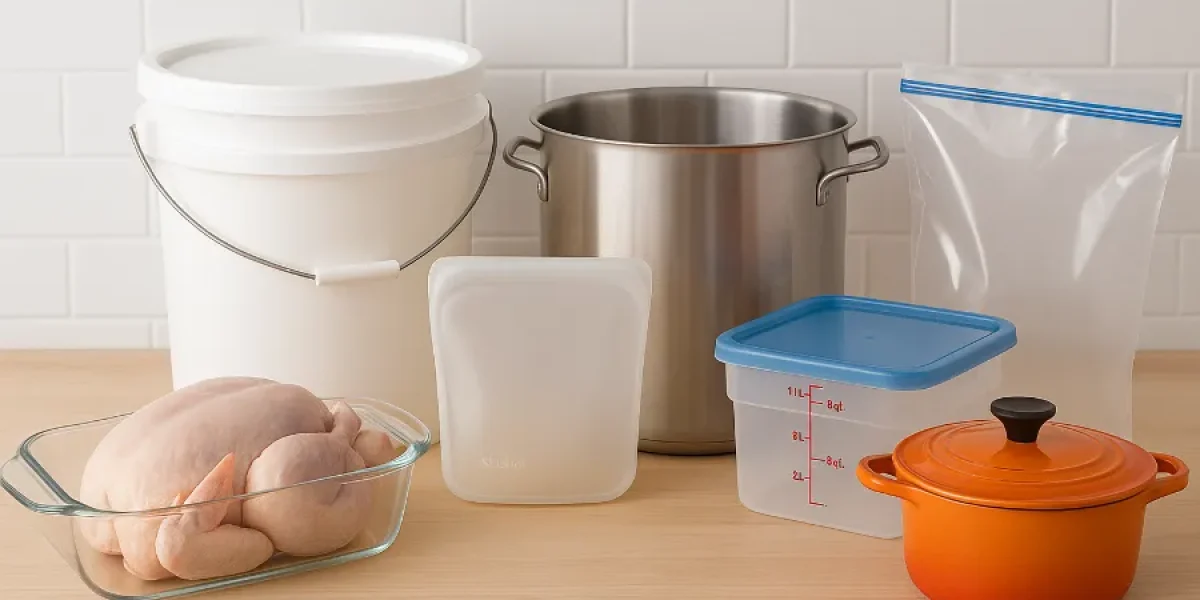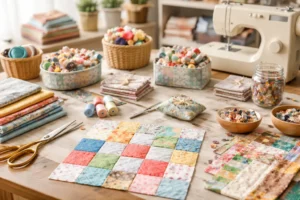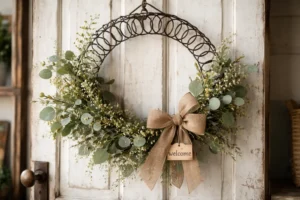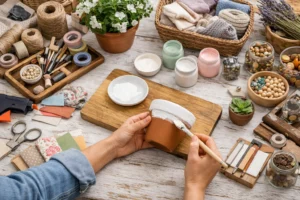If you’ve ever tasted perfectly juicy, flavorful chicken, chances are it started with a good brine — and the right vessel.
I learned this the hard way years ago when I used the wrong pot, and my brined chicken came out tasting faintly metallic. Since then, I’ve become borderline obsessive about finding the best brining container — one that’s food safe, leakproof, and big enough for the job.
Choosing the right container might sound like a tiny detail, but trust me, it’s what separates “eh, that’s fine” chicken from “wow, this is perfect” chicken. A good brining setup keeps your brine clean, cold, and evenly distributed — no weird flavors, no food safety scares, just tender, perfectly seasoned meat every time.
Here’s everything I’ve learned about how to pick the best container for brining chicken safely, plus my personal favorites that actually hold up in the real world.
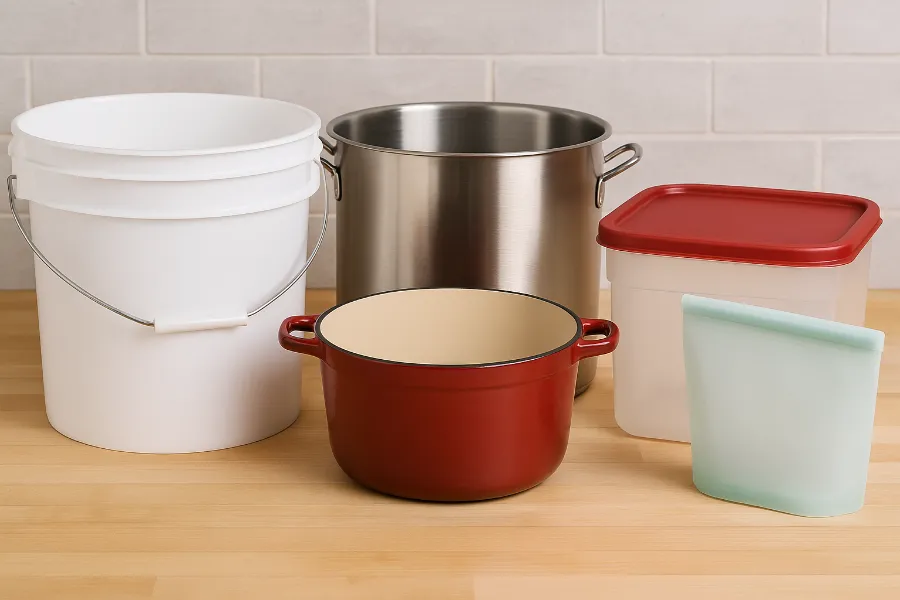
Why the Best Brining Container Matters
Brining is a science and an art — salt draws moisture into the meat, while sugar and aromatics build flavor. But brine itself is powerful: it’s salty, sometimes acidic, and can react with the wrong materials.
A good container has to do three things:
- Keep everything food-safe and nonreactive.
- Hold your brine at a safe temperature (below 40°F / 4°C).
- Fit in your fridge without spilling or leaking all over your shelves.
When you think about it, the container is almost as important as the brine recipe. Using the wrong one can ruin texture, introduce metallic tastes, or even make food unsafe.
My Top 10 Containers for Brining Chicken Safely
Over the years, I’ve tested just about everything — pots, bags, bins, and buckets — to find what works best. These are my 10 favorite containers, from affordable options to professional-grade picks.
1. Cambro 12-Quart Square Food Storage Container
My number one pick. Every pro kitchen I’ve ever worked in uses Cambro. The 12-quart translucent version is perfect for whole chickens or spatchcocked birds.
- Material: Food-grade polypropylene (PP)
- Why it’s great: Marked measurements for easy brine mixing, stackable, and virtually indestructible.
- Bonus: The square shape saves fridge space.
It’s food-safe, nonreactive, and built to last for years. If you want the best balance of practicality and safety, this is it — the best brining container for both new cooks and seasoned pros.
2. Rubbermaid Commercial Brining Bucket
When people ask me for a go-to brining bucket, I almost always say Rubbermaid. Their Commercial Space-Saving line is NSF-certified and used in professional kitchens for a reason.
- Material: Polypropylene
- Capacity: 12–22 quarts
- Why it’s great: Food-safe, durable, and easy to clean.
It’s an affordable, trustworthy food safe plastic container that fits perfectly in most home fridges. Just make sure to buy the Commercial version, not the regular household ones — those aren’t built for long salt exposure.
3. The Briner (or Briner Jr.)
If you’ve ever struggled to keep your chicken fully submerged, The Briner is genius. It comes with a locking plate that presses the meat below the liquid so nothing floats.
- Why it’s great: No more weights, no floating chicken, no guesswork.
- Sizes: Briner Jr. for smaller birds; full-size Briner for turkeys or multiple chickens.
- Material: Food-grade HDPE plastic.
It’s a bit bulky and single-purpose, but it takes all the frustration out of wet brining.
When I’m doing a big holiday bird, this is my go-to.
4. Food-Grade 5-Gallon HDPE Bucket with Gamma Seal Lid
If you do large batches — or you like to brine for big family cookouts — a food-grade 5-gallon bucket is a must.
Look for HDPE #2 plastic with a Gamma Seal lid, which twists on airtight. I like the white Leaktite Food-Safe Buckets you can find online.
- Why it’s great: Cheap, huge, and easy to clean.
- Perfect for: Big chickens, turkeys, or multiple birds.
Just double-check that it’s labeled food-grade. Never use hardware-store paint buckets — they’re not safe for food.
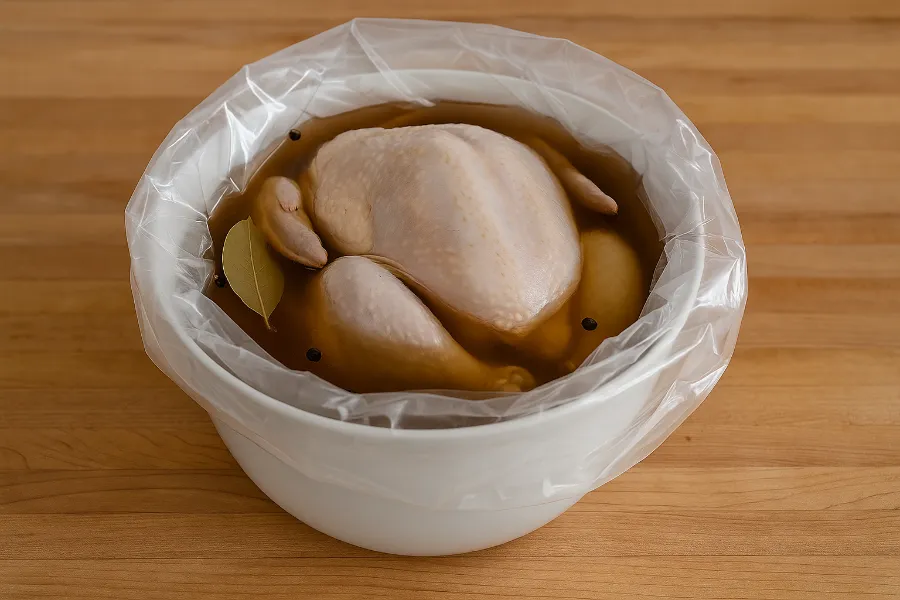
5. Brining in Stainless Steel Stockpot
Yes, brining in stainless steel is 100% safe — as long as it’s high-quality 18/8 or 18/10 steel. I’ve used my Cuisinart Chef’s Classic 16-quart stockpot for years.
- Why it’s great: Nonreactive, easy to sanitize, and doubles as your soup pot.
- Bonus: You can chill the brine right in the same pot using an ice bath.
If you already own a big stainless stockpot, you don’t even need to buy anything new. Just make sure the lid fits snugly and you have enough space in your fridge.
6. Enameled Dutch Oven (Le Creuset or Lodge)
For smaller birds or chicken parts, an enameled cast-iron Dutch oven is elegant and practical. The enamel coating keeps the metal from reacting with salt, and the heavy lid holds meat below the brine.
- Why it’s great: Beautiful, durable, and nonreactive.
- Best for: Half chickens or bone-in thighs.
- Tip: Never use if the enamel is chipped — that exposes raw metal underneath.
This option makes small-batch brining feel classy — perfect for dinner parties or date-night prep.
7. Carlisle StorPlus Food Box (12–18 Quarts)
When I’m brining a spatchcocked chicken (flattened for roasting), a wide, flat container like the Carlisle StorPlus is perfect.
- Why it’s great: Wide base = even coverage; stackable for space-saving.
- Material: Food-safe polypropylene.
Just be careful not to overfill; the wide design can spill if you move it too fast. But for even brining and easy cleaning, it’s hard to beat.
8. Anchor Hocking Glass Brining Dish
Sometimes I prefer glass for smaller brines — especially if I’m using acidic ingredients like lemon or vinegar.
Anchor Hocking makes beautiful, durable glass dishes with tight lids that don’t absorb odors.
- Why it’s great: Nonreactive, clear, and dishwasher-safe.
- Best for: Chicken wings, breasts, or thighs.
I use these for weeknight meal prep when I’m short on fridge space.
9. Stasher 2-Gallon Silicone Brining Bag
Now let’s talk about my eco-friendly favorite — the Stasher brining bag.
It’s made from platinum silicone, so it’s reusable, nonreactive, and completely safe for brining. It’s perfect for smaller chickens or boneless cuts.
- Why it’s great: Reusable, flexible, leak-resistant.
- Downside: Not quite big enough for a full large bird.
If you care about sustainability or live in a small space, this reusable brining bag is worth every penny.
10. Reynolds Turkey-Size Brining Bag
And finally, the classic disposable brining bag that started it all: Reynolds Turkey Bag.
It’s ideal for one-off brines, especially around the holidays when you need to fit a chicken or turkey into tight fridge space.
- Why it’s great: Inexpensive, easy, and disposable.
- Best tip: Always double-bag inside a bowl or pot in case of leaks.
This is the ultimate quick-fix solution when you want simplicity without scrubbing a container afterward.
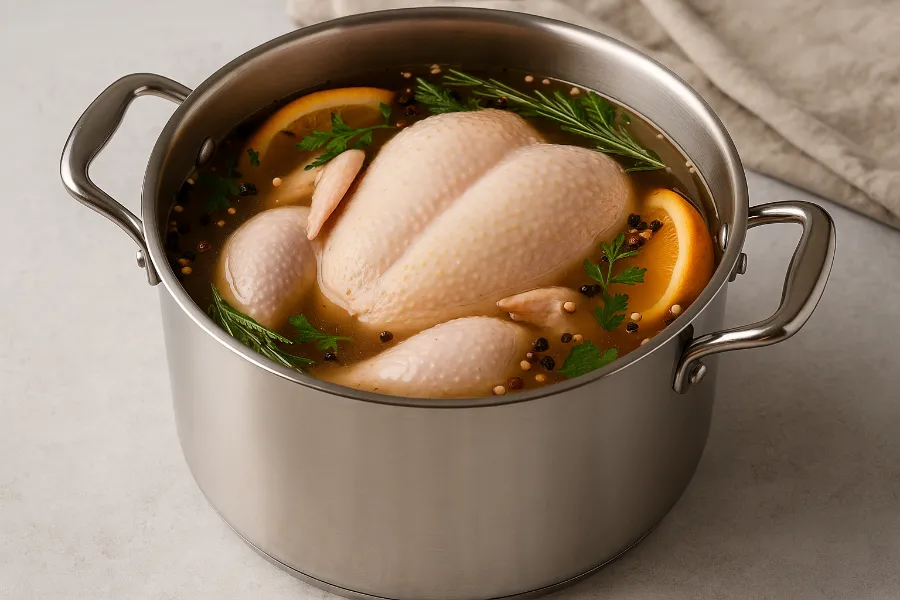
Brining Bucket: My Tried-and-True Workhorse
If you ask me what’s the single best way to brine a large chicken — I’d say a brining bucket.
It’s roomy, reliable, and built for both safety and convenience.
My Rubbermaid Commercial brining bucket has been with me for years. It’s made of NSF-certified food-safe plastic and fits perfectly on the bottom shelf of my fridge. It’s big enough for a 4-5 lb chicken with plenty of brine, but still easy to carry and clean.
When you’re brining multiple birds or prepping for a holiday dinner, a brining bucket is the hero you never knew you needed.
Brining Bag: When You Need Space-Saving Convenience
Not everyone has room for a big bucket — and that’s where a brining bag shines.
If you’re working with a tight fridge or limited kitchen space, brining bags let you use less liquid while keeping the chicken fully submerged. They squeeze the brine evenly around the bird, helping flavor penetrate faster.
For everyday cooking, I love the Stasher silicone bag. For bigger birds or one-time use, I go with the Reynolds brining bag double-layered in a stockpot for safety.
Just don’t use ordinary trash bags — they’re not food-safe!
Food Safe Plastic Container: The Everyday Essential
When you start brining regularly, a food safe plastic container becomes your best friend.
The ones made from HDPE (#2) or PP (#5) are completely nonreactive and easy to clean.
I’ve had both Rubbermaid and Cambro containers for years, and they’ve never failed me.
Here’s how to tell you’re using the right kind:
- Check the bottom for the recycling code 2 or 5.
- Look for NSF certification or “food safe” labels.
- Avoid plastics labeled 3, 6, or 7 — those can leach chemicals.
These containers are tough enough for daily use, stack neatly, and wash up beautifully.
Brining in Stainless Steel: Safe and Professional
There’s a lot of confusion around brining in stainless steel, but here’s the truth: it’s completely safe — as long as it’s real stainless (not aluminum).
Stainless steel doesn’t react with salt or acid, so it won’t affect flavor. I use my Cuisinart 16-quart stockpot for small chickens and my Tramontina 20-quart for large ones.
It’s easy to keep clean, doubles as a soup pot, and looks good doing it.
Just make sure your pot is labeled 18/8 or 18/10 — that’s food-grade stainless.
Rubbermaid: The Unsung Hero of Home Brining
I can’t write about the best brining containers without giving Rubbermaid a spotlight.
Their Commercial Space-Saving line (not the household storage bins) is perfect for brining. The square design makes them fridge-friendly, and the lids fit tight enough to prevent leaks or odors.
I love that they’re BPA-free, food-safe, dishwasher-safe, and last practically forever.
If you brine often — or plan to start — a Rubbermaid food-safe plastic container is the best investment you can make.
What Can I Use Instead of a Brining Bag?
This is probably the most common question I get from friends when they’re prepping for Thanksgiving:
“What can I use instead of a brining bag?”
Good news — you have lots of safe options:
- A food-grade HDPE bucket: Great for big birds or multiple chickens.
- Stainless steel stockpot: Perfect if you already own one.
- Enameled Dutch oven: Ideal for small chickens or pieces.
- Cambro or Rubbermaid containers: Excellent reusable options.
- Reusable silicone brining bag: Like the Stasher Mega — eco-friendly and easy to clean.
The key is nonreactive and food-safe. Don’t ever use trash bags, paint buckets, or random storage bins — they’re not made for food contact.
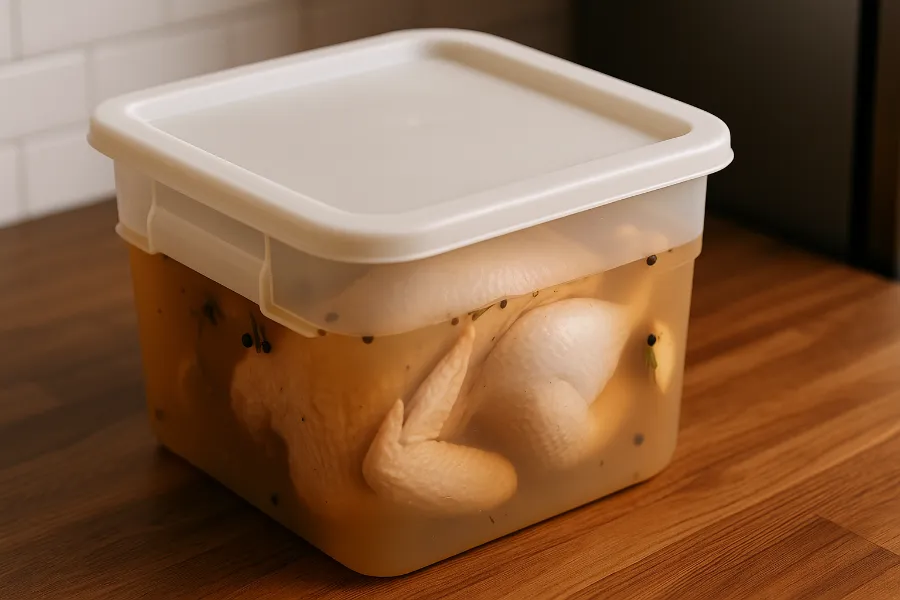
The Harms of Using the Wrong Brining Container
If your brined chicken tastes strange or feels mushy, your container might be to blame. Here’s what can go wrong:
- Chemical leaching: Cheap plastics or old containers can release toxins.
- Metal reaction: Aluminum or copper makes brine metallic and discolored.
- Unsafe temperatures: Overfilled containers that don’t fit in the fridge risk bacteria growth.
- Leaks and cross-contamination: Thin bags or cracked bins can drip raw brine.
The takeaway? Invest once in a safe, high-quality container — your food (and your fridge) will thank you.
The Benefits of the Right Brining Container
A little attention to the container makes a big difference in results. The right vessel gives you:
- Cleaner, purer flavor
- Juicier, more evenly seasoned chicken
- Easier temperature control
- Better food safety
- Less mess and easier cleanup
Whether it’s a Cambro bin, a Rubbermaid bucket, or a Stasher bag, the right container keeps your kitchen organized and your food delicious.
My Final Picks: The Best Brining Containers for Every Kitchen
Here’s how I’d sum it up:
| Category | Best Container | Why I Love It |
|---|---|---|
| Overall Best | Cambro 12-Quart Translucent | Food-safe, durable, space-saving |
| Best Budget | Rubbermaid Commercial 12-Quart | Reliable, affordable, easy to clean |
| Most Foolproof | The Briner | Keeps meat submerged automatically |
| Best for Big Batches | HDPE 5-Gallon Bucket + Gamma Lid | Massive capacity, airtight |
| Best Eco Option | Stasher 2-Gallon Silicone Bag | Reusable and space-saving |
| Best Small Batch | Le Creuset Dutch Oven | Nonreactive, gorgeous, long-lasting |
The Bottom Line
At the end of the day, the best brining container is the one that fits your space, your cooking style, and your commitment to safety.
For me, it’s a Rubbermaid or Cambro container for everyday use, and a Stasher bag when I want something lighter and reusable.
Whichever you choose, the goal is the same: keep your chicken cold, submerged, and safely contained — so you end up with that perfect juicy bite every time.
Once you taste what a good brine (and a great container) can do, you’ll never go back.
FAQs
The best brining container is a food-safe, nonreactive vessel like a Cambro or Rubbermaid polypropylene bin. These keep your brine cold, clean, and evenly distributed for juicy results.
Only if it’s labeled food-grade HDPE or PP. Hardware store buckets may contain chemicals that can leach into your brine and affect food safety.
Yes — brining in stainless steel is perfectly safe as long as it’s high-quality 18/8 or 18/10. Avoid aluminum or copper, which can react with salt.
Use a stainless pot, food-safe plastic container, or HDPE bucket. These options are reusable, durable, and safer than single-use plastic bags.
Disposable brining bags like Reynolds are not meant to be reused. For a reusable option, try a silicone brining bag such as the Stasher 2-gallon Mega.
Check for recycling codes #2 (HDPE) or #5 (PP) and look for an NSF or “food safe” label. Avoid any plastic that’s scratched, discolored, or unlabeled.
The wrong material can cause metallic flavors, bacterial growth, or chemical leaching. A food-safe, nonreactive container ensures your chicken stays flavorful and safe to eat.

